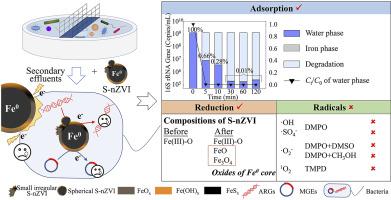当前位置:
X-MOL 学术
›
Environ. Pollut.
›
论文详情
Our official English website, www.x-mol.net, welcomes your feedback! (Note: you will need to create a separate account there.)
Sulfidated nanoscale zero-valent iron is an efficient material for the removal and regrowth inhibition of antibiotic resistance genes.
Environmental Pollution ( IF 8.9 ) Pub Date : 2020-04-03 , DOI: 10.1016/j.envpol.2020.114508 Wen-Zhi Zhang 1 , Jing-Feng Gao 1 , Wan-Jun Duan 1 , Da Zhang 1 , Jing-Xin Jia 1 , Yu-Wei Wang 1
Environmental Pollution ( IF 8.9 ) Pub Date : 2020-04-03 , DOI: 10.1016/j.envpol.2020.114508 Wen-Zhi Zhang 1 , Jing-Feng Gao 1 , Wan-Jun Duan 1 , Da Zhang 1 , Jing-Xin Jia 1 , Yu-Wei Wang 1
Affiliation

|
Antibiotic resistance genes (ARGs) and mobile gene elements (MGEs), the emerging genetic contaminants, are regarded as severe risks to public health for impairing the inactivation efficacy of antibiotics. Secondary effluents from wastewater treatment plants are the hotspots for spreading these menaces. Herein, sulfidated nanoscale zero-valent iron (S-nZVI) was occupied to remove ARGs and MGEs in secondary effluents and weaken the regrowth capacity of their bacterial carriers. The effects of S/Fe molar ratios (S/Fe), initial pH and dosages on 16S rRNA and ARGs removal were also investigated. Characterization, mass balance and scavenging experiments were conducted to explore the mechanisms of the gene removal. Quantitative PCR (qPCR) and high throughput fluorescence qPCR showed more than 3 log unit of 16S rRNA and seven out of 10 ARGs existed in secondary effluent could be removed after S-nZVI treatment. The mechanisms might be that DNA accepted the electron provided by the Fe0 core of S-nZVI after being adsorbed onto S-nZVI surface, causing the decrease of 16S rRNA, ARGs and lost their regrowth capacity, especially for typical MGE (intI1) and further inhibiting the vertical gene transfer (VGT) and intI1-induced horizontal gene transfer (HGT). Fe0 core was oxidized to iron oxides and hydroxides at the same time. High throughput sequencing, network analysis and variation partitioning analysis revealed the complex correlations between bacteria and ARGs in secondary effluent, S/Fe could directly influence ARGs variations, and bacterial genera made the greatest contribution to ARGs variations, followed by MGEs and operational parameters. As a result, S-nZVI could be an available reductive approach to deal with bacteria and ARGs.
中文翻译:

硫化的纳米级零价铁是用于去除和抵抗抗生素抗性基因的有效材料。
新兴的遗传污染物抗生素抗性基因(ARGs)和移动基因元素(MGEs)被认为会损害抗生素的灭活功效,对公共健康构成严重威胁。来自废水处理厂的二次废水是散布这些威胁的热点。在这里,硫化的纳米零价铁(S-nZVI)被占据,以去除次级流出物中的ARG和MGE,并削弱其细菌载体的再生能力。还研究了S / Fe摩尔比(S / Fe),初始pH和剂量对16S rRNA和ARGs去除的影响。进行了表征,质量平衡和清除实验以探索基因去除的机理。定量PCR(qPCR)和高通量荧光定量PCR显示,经S-nZVI处理后,可去除二级流出物中存在的3个log单位以上的16S rRNA,并且可以去除次级污水中存在的10个ARG中的7个。其机制可能是DNA被S-nZVI表面吸附后接受了S-nZVI Fe0核心提供的电子,导致16S rRNA,ARG的减少并失去了再生能力,特别是对于典型的MGE(intI1)以及进一步抑制垂直基因转移(VGT)和intI1诱导的水平基因转移(HGT)。Fe0核同时被氧化为氧化铁和氢氧化铁。高通量测序,网络分析和变异分区分析揭示了次级废水中细菌与ARG之间的复杂关系,S / Fe可以直接影响ARG的变异,细菌属对ARGs变异的贡献最大,其次是MGE和操作参数。因此,S-nZVI可能是可用于处理细菌和ARG的还原方法。
更新日期:2020-04-20
中文翻译:

硫化的纳米级零价铁是用于去除和抵抗抗生素抗性基因的有效材料。
新兴的遗传污染物抗生素抗性基因(ARGs)和移动基因元素(MGEs)被认为会损害抗生素的灭活功效,对公共健康构成严重威胁。来自废水处理厂的二次废水是散布这些威胁的热点。在这里,硫化的纳米零价铁(S-nZVI)被占据,以去除次级流出物中的ARG和MGE,并削弱其细菌载体的再生能力。还研究了S / Fe摩尔比(S / Fe),初始pH和剂量对16S rRNA和ARGs去除的影响。进行了表征,质量平衡和清除实验以探索基因去除的机理。定量PCR(qPCR)和高通量荧光定量PCR显示,经S-nZVI处理后,可去除二级流出物中存在的3个log单位以上的16S rRNA,并且可以去除次级污水中存在的10个ARG中的7个。其机制可能是DNA被S-nZVI表面吸附后接受了S-nZVI Fe0核心提供的电子,导致16S rRNA,ARG的减少并失去了再生能力,特别是对于典型的MGE(intI1)以及进一步抑制垂直基因转移(VGT)和intI1诱导的水平基因转移(HGT)。Fe0核同时被氧化为氧化铁和氢氧化铁。高通量测序,网络分析和变异分区分析揭示了次级废水中细菌与ARG之间的复杂关系,S / Fe可以直接影响ARG的变异,细菌属对ARGs变异的贡献最大,其次是MGE和操作参数。因此,S-nZVI可能是可用于处理细菌和ARG的还原方法。



























 京公网安备 11010802027423号
京公网安备 11010802027423号